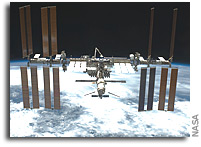NASA International Space Station Lead Increment Scientist’s Highlights, w/e March 14, 2011

(Highlights: w/e March 14, 2011) — The Capillary Channel Flow, or CCF, has completed the first half of its operations on the station. So far, the experiment has collected 1,574 hours of operation with live Microgravity Science Glovebox camera coverage, more than 400,000 images, 900 high resolution data points, and 1,300 ground inspected data points. This experiment tests the theoretical predictions for the free surface shapes and the critical flow velocities for open capillary channel flows in microgravity to improve future spacecraft fuel tanks.
Through March 16, the Crew Earth Observation, or CEO, team has received 19,248 images. Station crew members captured photos of the tsunami damage to the Japanese coastal town of Higashimatsushima from an altitude of 220 miles. Both agricultural fields and settled areas are submerged by muddy water, while the crisscrossing runways at Matsushima Airport are surrounded. For this experiment, station crew members photograph natural and human-made changes on Earth. These images provide researchers with key data to better understand the planet.
The Hyperspectral Imager for the Coastal Ocean, or HREP-HICO, Experiment Payload has taken 2,732 images to date, including recent images of part of the North Carolina coast, the Long Island Sound, the coast of Italy near Venice and Tokyo Bay. The experiment analyzes the water clarity, chlorophyll content, water depth and ocean or sea floor composition for naval purposes.
The Remote Atmospheric and Ionospheric Detection System, or HREP-RAIDS, is collecting secondary science including nighttime atmospheric disk photometry, spectra and temperatures. RAIDS provides density, composition, temperature and electron density profiles at altitudes between 95 and 300 kilometers.
Vic Cooley, Lead Increment Scientist Expedition 27/28









